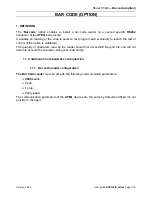
RadioProcessor-G
IV. Example Gradient Echo MRI Experiment
The RadioProcessor Model G comes with multiple sample programs. One of these programs is a gradient echo MRI
pulse sequence. A diagram of the pulse sequence can be seen in Figure 4. The program is a .c file that is compiled into
a .exe that requires command line arguments. There are included Windows batch file scripts that handle those arguments
so that scans can be run by simply editing the .bat file and then double-clicking it in Windows. The below steps will guide
you through using the gradient echo example program.
1.
Download and install the latest MRI SpinAPI package.
2. Connect the RadioProcessor-G as shown in Figure 2. Note that all components shown in Figure 2
may be purchased from SpinCore Technologies.
3. Edit the 2D_MRI.bat batch file by right-clicking and selecting 'edit' and save the batch file when
finished. The parameters of interest for this experiment are described below.
4. Run the 2D_MRI.bat file by double-clicking. Once the 2D_MRI.bat file has completed, new files (*.fid,
*.txt, *.bmp) will be created in the directory from which the batch file was executed. The bitmap will be
an image such as the one in Figure 3.
outputFilename:
A string of text that is used to name all of the files generated by GradientEcho.exe
nPoints:
Number of points acquired per acquisition period.
nScans:
Number of times the entire sequence is performed.
nPhases:
Number of different phase levels to run the scan for
spectrometerFrequency_MHz:
Frequency of the RF excitation pulse in MHz.
spectralWidth_kHz:
The desired spectral width in kHz.
linebroadening_value:
A value that adjusts the amount of line broadening in the final image. 0
corresponds to no line broadening and 5 is a lot of line broadening.
RF_Shape:
Denotes the shape of the RF pulse. A value of 0 is a hard pulse. A value greater than 1 is a
sinc with RF_Shape many lobes.
amplitude:
The amplitude of the RF pulse. Valid values range from 0.0 to 1.0.
pulseTime_us:
The duration of the RF pulse in microseconds.
transTime_us:
The delay between RF excitation and phase gradient application.
phaseTime_us:
The duration of the phase gradients in microseconds.
gradientEchoDelay_us:
The delay between switching the readout gradient's direction and data
acquisition.
repetitionDelay_s:
The delay between acquisition and the next RF pulse in seconds.
tx_phase:
The phase of the RF excitation pulse in degrees.
blankingBit:
The bit connected to the blanking/de-blanking pin of your RF amplifier. This is designed
for SpinCore's power amplifiers. More information on the amplifiers can be found at
http://www.spincore.com/products/RFPA/RF-Power-Amplifier.shtml
blankingDelay_ms:
The amount of time to de-blank the amplifier before the RF pulse starts.
adcOffset:
The adc DC offset specific to the current board.
2017-09-04
15
www.spincore.com








































